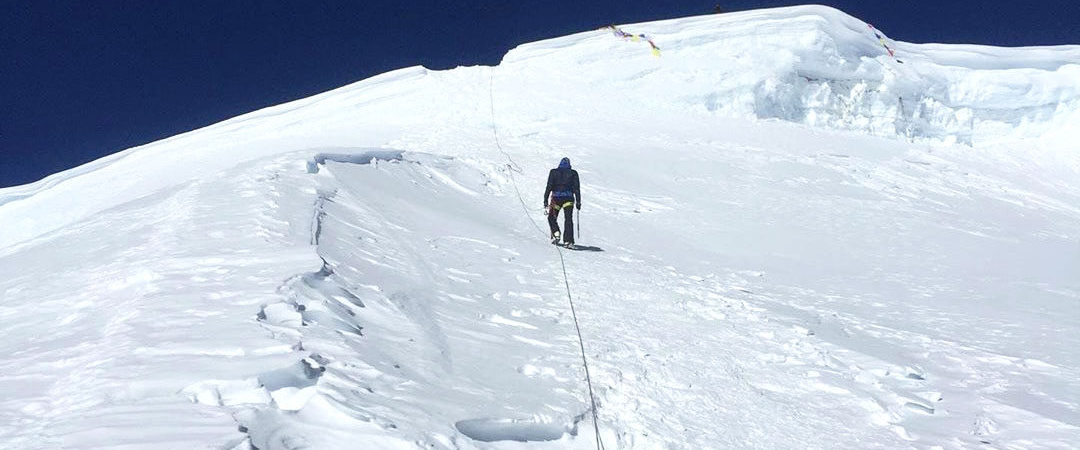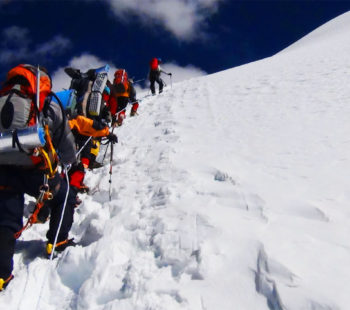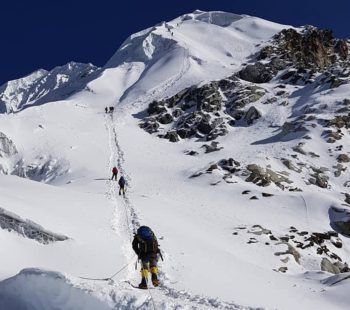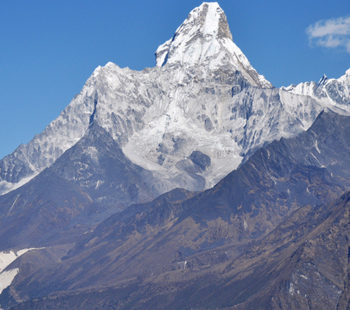
Mera Peak is an inimitable trekking peak for novice adventurers although the peak is 6476 m high from the sea level. At this altitude, the air contains a low level of oxygen what it lies on sea level. So, we don’t recommend you to Mera Peak Climbing if you have not hiked above 3000 m altitude before. But it does not require high mountaineering skills.
Hundreds of climbers visit the Khumbu region to summit the peak every year. From the summit of the Mera Peak, the stunning view of the world’s 4 tallest mountains can be enjoyed.
The Mera Peak follows a separate route as it does not go through Namche although all the treks of Khumbu pass through Namche Bazaar. It literally means this trip takes you away from Everest crowds, while you will approach the beautiful Arun valley. Meanwhile, you will also see local farming terraces and their living styles.
The Mera Peak itinerary below is carefully designed to have proper acclimatization with steady walk.
Day 01: Arrival in Kathmandu (1,300m/4,264ft)
Day 02: Kathmandu: trip preparation or sightseeing (optional)
Day 03: Fly to Lukla, trek to Paiya (Chutok) (2,730m/8,956ft): 40 mins flight, 5-6 hours trek
Day 04: Paiya to Panggom (2,846m/9,337ft): 5-6 hours
Day 05: Panggom to Ningsow (2,863m/9,393ft): 4-5 hours
Day 06: Ningsow to Chhatra Khola (2,800m/9,186ft): 7-8 hours
Day 07: Chhatra Khola to Kothe (3,691m/12,109ft): 6-7 hours
Day 08: Kothe to Thaknak (4,358m/14,297ft): 3-4 hours
Day 09: Thaknak to Khare (5,045m/16,486ft): 2-3 hours
Day 10: Khare: Acclimatization and pre-climb training
Day 11: Khare to Mera High Camp (5,780m/18,958ft): 6-7 hours
Day 12: Mera High Camp to Summit (6,461m/21,1907ft) and back to Khare (5045m/16,547ft): 8-9 hours
Day 13: Reserve Day for Contingency
Day 14: Khare to Kothe (3600m/11808ft): 4-5 hours
Day 15: Kothe to Thuli Kharka (4,300 m/14,107ft): 5-6 hours
Day 16: Thuli Kharla to Lukla via Zatrwa La pass: 6-7 hours
Day 17: Fly to Kathmandu
Day 18: Final departure
After your arrival in Kathmandu, you will directly move toward the Hotel as the same day is hardly possible to set up for Kathmandu to Lukla flight. If you arrive earlier in the day, then you can visit around the Thamel – a tourist hub in the center of the Kathmandu while the second day will be your trip preparation day or sightseeing of Kathmandu optionally.
Similar to the trail of Island Peak Climbing and other trekking and climbing in the Everest region, initially you need to take a domestic flight to Lukla from Kathmandu. But you walk toward Paiya village from Lukla rather than following the path of Everest Base Camp. Throughout the trail, you will be walking along the Jungle, crosses a suspension bridge over Handi Khola and reach Surke Village. After that, to continue the trek, you cross Chutok La Pass before reaching Paiya – a small tea house settlement area.
By continuing the trek, you will trek toward Khare. It will be the 9th day of your trip to arrive at Khare. From here, the southern face of Mera Peak is visible.
Before reaching Khare, you need to pass through a few villages like Nigsow, Chhatra Khola, Kothe, and Thaknak. Meanwhile, you get to experience the trip in a different way than any other adventure journey you have done before. As such, you will walk along with a few steps of the slippery trail, cross the number of passes, enter into the Makalu Barun National – home to several alpine and sub-alpine species and plants. In addition, you also can explore the 200 years old Lungsumgba Gompa.
After reaching Khare, you will take an acclimatization day for pre-climbing training. The very next day, you will set your path toward Mera Peak High Camp 5780 m and arrive in approximately 7 hours. Today, you need to spend your night at camping in High Camp of Mera Peak.
Finally, the most important day arrives as you will be going to summit Mera Peak today. Around at 2:00 am, you wake up for breakfast before moving toward the summit. Obviously, it will be very cold as you will be at an altitude of 5780 m. Although the peak is non-technical, you will take a gradual pace of walk and reach on the top within 6 – 7 hours. Now, you will be enjoying the stunning view of the mighty Himalayas including Mt. Everest (8848 m), Cho Oyu (8201 m), Lhotse (8516 m), Makalu (8463 m ), Kanchenjunga (8586 m) and many other peaks.
After spending a few times there, you will retrace the same trail to come down to high camp. Likewise, you will also take the same steps to come back to Lukla where you can chill out enjoying the success party, and finally, you reach at Kathmandu by taking the domestic flight from Lukla.
Tea House is the only option where you get meals and accommodation while you are on the way to climbing Mera Peak. Indeed, there is no luxurious hotel in the region, whereas, you will stay at a hotel in Kathmandu.
Tea House serves both the foods and accommodation to the trekkers and climbers. In a tea house, you will stay in the twin-shared room as it is hard to get a single room in the mountain. But sometimes it is possible to get a single room by paying an additional amount.
In the tea houses, you often get limited meal options to choose from. You can taste Nepali foods, Indian Continental as well as continental cuisine. If you go through any tour operator, most of them provide one menu item only.
Mera Peak is a trekking peak. It literally means that Mera Peak does not require a high level of climbing experience. If you want to climb Mera Peak, you need to be physically fit and have some hiking experience. However, rope using technique and climbing experience is worthwhile while climbing the peak.
Basically, Mera Peak climbing is supposed to be perfect for Autumn and Spring seasons because weather and climate used to be suitable for trekking and climbing in the mountains of Nepal. For more detail about climate and weather, you can log in to our article the best season to travel in Nepal.
Preparation of equipment and packing list is essential which can’t be forgotten. Basically, the packing list and equipment for Mera Peak Climb are similar to the other trekking peaks of Nepal. As such, you can use ditto gears that are suggested to climb the Island Peak.
Basic types gears for Mera Peak Adventure:
The most essential climbing gears are given below:
According to the many climbers, they believe the peak is worthwhile to climb as it offers a stunning view of highest mountains in the world including the highest and 3rd highest mountains Mt. Everest (8848 m) and Kanchenjunga (8586 m) respectively.
Yes, you can see the Mt Everest from the top of the Mera Peak. And the view of the Mt Everest and other tallest mountains seems closer to the summit of Mera Peak.
Both Mera Peak and Island Peak are considered to be the trekking peak as these peaks do not require high climbing technique and preparation. A beginner hiker or adventurer who is willing to get hiking experience in the high altitude of the Himalayan peak, s/he can choose Mera Peak rather than Island Peak. The Mera Peak is higher than Island Peak but even easier to summit than Island Peak as you will be walking steep path until reaching the summit.
Let check out more travel information

Island Peak Climbing is an expedition of glacier travel, snow and ice climbing and trekking in the Khumbu region which…

The Lobuche Peak locates near the Khumbu Glacier consisting of two different summits – east and west with an altitude…

Mt Ama Dablam is a beautiful mountain situated in Everest Region, and its height is 6812 m. Indeed, Ama Dablam…